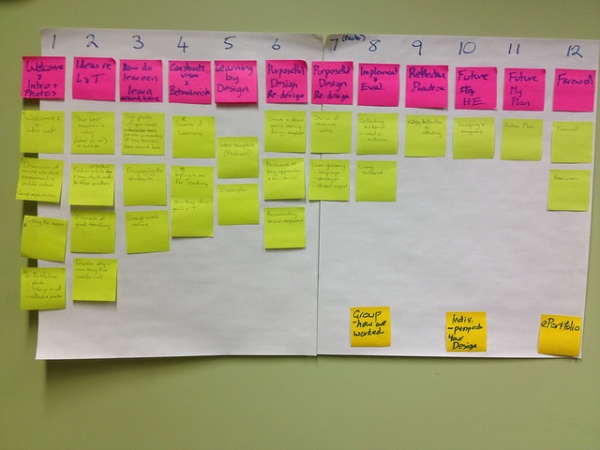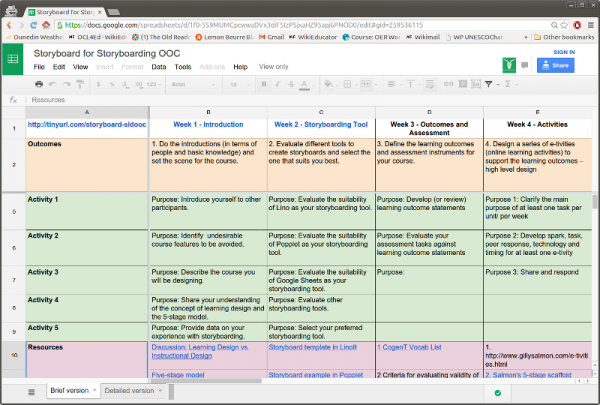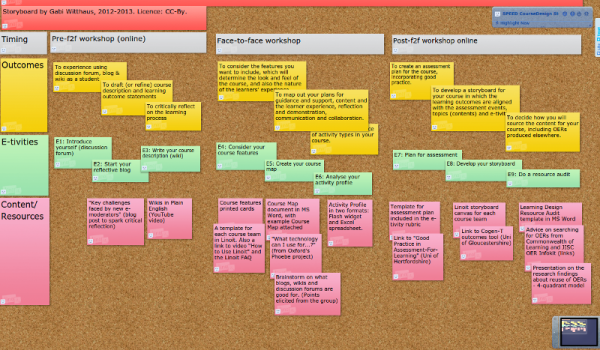In this section, we:
- Introduce a few technologies you can use for generating storyboards
- Provide examples of storyboards
- Spend a few minutes exploring each option with a view to selecting a tool you would like to use when producing your own storyboard.
Flipcharts, sticky notes and markers
The traditional way of creating storyboards is to use flipcharts with sticky notes. To create a storyboard in this way, you will need a flipchart with paper or a whiteboard, sticky notes of different colours, and markers. You can take pictures with a digital camera to share your work. This can work well in face-to-face development workshops.

Example storyboard using flipchart paper
Spreadsheets
Spreadsheets (for example, LibreOffice Calc or Microsoft Exel) are probably the most versatile application for developing storyboards. Many people know how to use a spreadsheet, and recording information digitally makes it easier to share with colleagues. Online options like the OnlyOffice or Collabora plug-ins for Nextcloud (Open Source) or Google Sheets (Proprietary) will enable teams to work collaboratively on the same storyboard.
A storyboard created with a spreadsheet will be highly structured, and will be organised in rows and columns.
With spreadsheets, you can use different colour backgrounds for the different components of the storyboard, and adjust the colour and size of the labels in the first row and column.

Example of storyboard using Google Sheets. Visit the online version
here.
Other software options
Software tools that allow you to place and move “notes” or “cards” into columns are useful for brainstorming sessions with team members.
For example, Lino is an online sticky note and photo sharing site. Lino works like a canvas where you can put virtual sticky notes (called ‘stickies’) of different colours with text and icons . You can also add images, videos and other files (not necessary to create a storyboard but nice to have). Several people can work on the same Lino canvas, which is useful for teams of designers. However, this is a proprietary application and the free version contains advertisements and has limited features compared to the premium paid version.

Example storyboard using Lino. Visit the online version
here.
If you are looking for an open source alternative to brainstorm a storyboard virtually with team members, Scrumblr is a good option. This tool requires no downloads and no sign-in, making it ideal for quick, instant storyboarding in workshops.
Consider ease of use and whether the tool is fit for the purpose of constructing a storyboard.
Acknowledgement
The content on this page was re-mixed from original materials developed by Gabi Witthaus and Brenda Padilla for the Storyboard for Storyboarding open course under a CC-BY-SA licence.
Key points
In this section, we:
Flipcharts, sticky notes and markers
The traditional way of creating storyboards is to use flipcharts with sticky notes. To create a storyboard in this way, you will need a flipchart with paper or a whiteboard, sticky notes of different colours, and markers. You can take pictures with a digital camera to share your work. This can work well in face-to-face development workshops.
Spreadsheets
Spreadsheets (for example, LibreOffice Calc or Microsoft Exel) are probably the most versatile application for developing storyboards. Many people know how to use a spreadsheet, and recording information digitally makes it easier to share with colleagues. Online options like the OnlyOffice or Collabora plug-ins for Nextcloud (Open Source) or Google Sheets (Proprietary) will enable teams to work collaboratively on the same storyboard.
A storyboard created with a spreadsheet will be highly structured, and will be organised in rows and columns.
With spreadsheets, you can use different colour backgrounds for the different components of the storyboard, and adjust the colour and size of the labels in the first row and column.
Other software options
Software tools that allow you to place and move “notes” or “cards” into columns are useful for brainstorming sessions with team members.
For example, Lino is an online sticky note and photo sharing site. Lino works like a canvas where you can put virtual sticky notes (called ‘stickies’) of different colours with text and icons . You can also add images, videos and other files (not necessary to create a storyboard but nice to have). Several people can work on the same Lino canvas, which is useful for teams of designers. However, this is a proprietary application and the free version contains advertisements and has limited features compared to the premium paid version.
If you are looking for an open source alternative to brainstorm a storyboard virtually with team members, Scrumblr is a good option. This tool requires no downloads and no sign-in, making it ideal for quick, instant storyboarding in workshops.
Consider ease of use and whether the tool is fit for the purpose of constructing a storyboard.
Acknowledgement
The content on this page was re-mixed from original materials developed by Gabi Witthaus and Brenda Padilla for the Storyboard for Storyboarding open course under a CC-BY-SA licence.
Project lead
Supported by
Development Partner